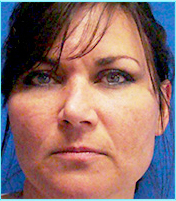Rhinoplasty-Recovery
Let’s assume that the procedure in question involves the entirety of the nose, and not just the tip. With that in mind, here is a typical course after nasal surgery.
Firstly, two weeks before surgery, all medications that may cause bleeding and delay clotting should be stopped with the approval of your primary care doctor if prescribed. Over-the-counter substances like Omega Fatty Acids, Vitamin E, aspirin, and aspirin-like products (ibuprofen, or naproxen) will cause bleeding during, and after surgery and can compromise results.
Immediately after surgery you will have a moustache dressing, either internal packing or an internal nasal splint an external splint. You will have swelling, pain, and tenderness, and gradually worsening periorbital ecchymosis (bruising about the eyes).
The first week:
The moustache dressing is so called because it is placed where a moustache would go and is simply a folded gauze placed under the nose and taped to the cheeks to catch any blood and/or nasal drip. It generally comes off within 6-24 hours after surgery.
Internal packing or internal nasal splints prevent hematoma (blood collection) in the septum (the partition between the two nasal passages. Channeled splints or flat splines like the Denver type splint, maintain pressure without completely occluding the nasal airway and are easier to tolerate. Both forms, however, are somewhat uncomfortable and only stay in overnight.
You will sleep in a recliner, or with your back propped up on several pillows, on your back to minimize the chances for external splint shift and/or nasal bone displacement. This also helps decrease swelling. Patients generally require 2-3 days of pain medication to control the initial acute postoperative pain as well as anti-nausea medication. Forceful sneezing and nose blowing should be avoided for at least two weeks, not only does this predispose to the risk of infection, but can also disturb the delicate framework of the reshaped nose. Drinking is to be avoided for the next two weeks, sports, especially contact sports, densely packed public places like bars, concerts, should be avoided for the first six weeks. Trauma in the immediate postoperative period can cause bone imperfections, bleeding, scarring, and tip displacement. Smoking is a big no-no, especially in the open approach and can lead to loss of parts of the nasal tip. Direct application of ice to the nasal tip is to be avoided. Cool packs to the cheeks may be used in the first 24 to 49 hours. Overall, this is toughest part of rhinoplasty-recovery.
The day after surgery, the drip dressing is removed, the internal packing or splints are removed, and the external incision, if present is cleaned up. The inside of the nose is checked for blood collections or persistent bleeding. The alignment of the external splint is checked and adjusted as needed.
The third week of rhinoplasty-recovery:
External nasal splints to maintain the fractured nasal bones in the desired position will be present for two weeks. The nose, especially the nasal tip will be swollen. The swelling will not only depend on the patient’s inflammatory response but also on the thickness of their nasal skin. This swelling will get considerably better in the coming months, but in thicker skinned noses, the process can take up to one year. Black eyes will have turned faded green and yellow, and by the third week, the color will start to disappear. Makeup can be used to cover any remaining discoloration.
Sixth week and out:
The telltale signs of surgery will disappear but numbness can persist as nerves that supply the nasal skin continue to grow. Direct sun exposure should be avoided for at least six months so as not to damage the newly undermined skin. The blood supply to the nasal tip should have been re-established, but it not uncommon to have persistent hyperemia or cyanosis in cold temperatures; this too can take a year to disappear.

Patient was ecstatic about her result.
Error: Contact form not found.